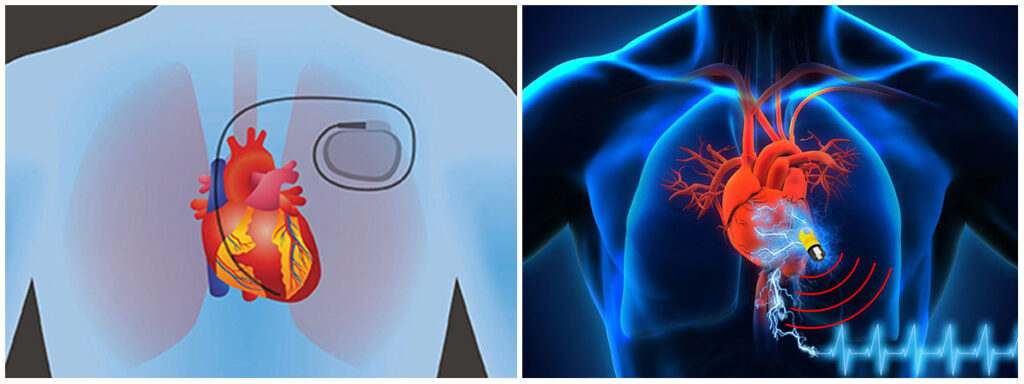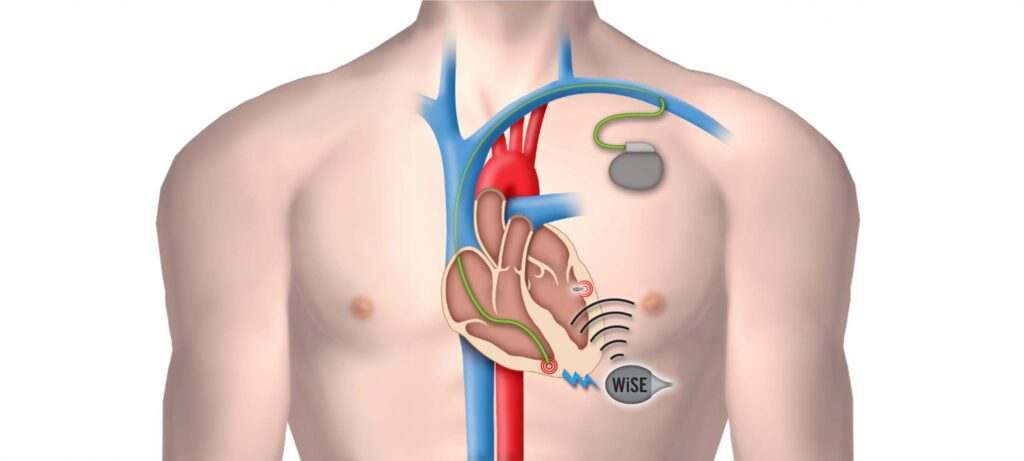A pacemaker of the heart is a device, implanted in a human heart to increase the heart rate if a patient suffers from symptomatic slow heart rate. A slower heart rate can happen due to different types of electrical block of the heart conduction system.
What are the Components of a Cardiac Pacemaker?
A cardiac pacemaker has a pulse generator (battery) and wires (leads) which connect the pulse generator with the heart. Cardiologists generally implant the pulse generator in a pocket made under the skin below the collar bone. At the time of insertion, the leads are embedded into the right side of the heart through the vein.
Leads are connected with the generator to transmit electricity to the heart from the pulse generator. Single chamber pacemaker of the heart has a single point to connect the pulse generator with the right lower chamber (right ventricle) of the heart. Whereas, the dual-chamber pacemaker has two leads which connect the pulse generator with the right upper chamber (right atrium) and right lower chamber (right ventricle).

How is the Pacemaker Implantation Performed?
Inserting a cardiac pacemaker tends to be a small procedure. The procedure of the pacemaker implantation is performed after your cardiologist injects local anaesthetic injection under the collar bone (right or left). A pocket is made under the skin to accommodate the pulse generator. With the help of a needle, a vein (subclavian or axillary vein) is puncture under the collar bone to get access to the right side of the heart.
The venous access leads are passed to the right side of the heart. Whereas, the furthest part of the points is fixed with the inner surface of the heart chambers. The outer ends of the leads are attached with the pulse generator. Once the operator is happy with the functions of electrical parameters of the pacemaker, the pocket is closed by suturing the tissues in layers, making sure there is no bleeding.
How Long the Patient Needs to Stay in the Hospital After Pacemaker Implantation?
Patients can be discharged on the 2nd or 3rd day of operation.
Is there Any Risk of the Pacemaker Implantation Procedure?
The pacemaker implantation procedure is very safe. Some complications may arise in the unlikely event. The odds of serious complications are in the range of 1%. Bleeding, infection, Pneumothorax (air may come out from the underlying lung causing shortness of breath if the lung gets injured inadvertently by the needle while puncturing the vein) and Pericardial Tamponade (if heart gets injury from the wire and blood accumulates in the pericardial sac outside the heart causing compression of the heart chambers) are some serious complications may arise in the unlikely event.
In the event of Pneumothorax, a chest tube is inserted to get the air out from the Pleural space around the lung. And in Pericardial Tamponade, a drain is placed around the heart to get the blood out from the area.
What are the Precautions a Patient Should Follow After the Implantation?
The patient should not expose himself to a high electromagnetic field. Should not have an MRI (If not MRI compatible pacemaker). The patient should avoid extremes of jerky limb movement on the side of the implant at least for a few weeks. Using household electrical gadgets and switches are okay for patients with pacemakers. Patients are advised not to fiddle with the pulse generator.
What is the Follow-Up Protocol for Cardiac Pacemaker Implantation?
After cardiac implantation, patients are asked to visit the clinic after seven days to make sure the wound has healed properly. A pacemaker check is performed after six weeks, and if every pacing parameters are satisfactory, then a yearly follow up pacemaker check is sufficient.
How Often a Pacemaker Battery Needs to Be Changed?
It depends on the amount of use of the pacemaker. If the patient’s heart uses pacemaker too often, the battery life shortens. Battery for the majority of the modern pacemaker of the heart lasts around 8 to 10 years after that period the pulse generator needs to be replaced. To determine the battery life of your pacemaker, you can consult with your cardio doctor at the earliest.

